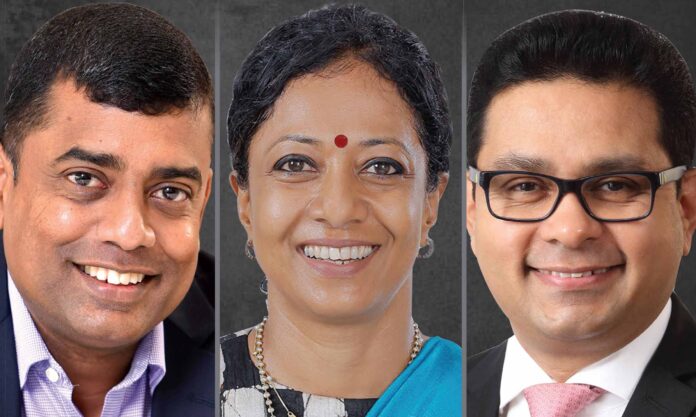By Sabrina Zavahir
Acknowledging the economic adversities and reacting analytically to overcome greater uncertainty is an iconic leadership skill.
A leader’s performance tends to become so vivid when they apply a few or multiple key strategic key behaviors which assists them to grid and inspire employees, shareholders and business partners of their respective enterprises through unimaginable difficult phases of time.
Business leader’s create a pathway towards a triumph forging in advance during crisis and at certain times applying rapid approaches to maintain an unwavering continuity in their respective industries.
We understand that operational leadership practices does respond effectively, therefore, we were privileged to connect with industry experts to share their perspective during an onset of a nation’s predicament.
They are Ms. Kasturi Chellaraja Wilson, Group Chief Executive Officer, Hemas Holdings PLC; Suren Fernando, Chief Executive Officer, MAS Holdings (Pvt) Ltd and Sanath Manatunge, Managing Director /Chief Executive Officer, Commercial Bank of Ceylon PLC, respectively.
Kasturi Chellaraja Wilson Group Chief Executive Officer Hemas Holdings PLC
“We have to restructure, right size businesses”
Q: Despite the current difficulties due to a volatile economic crisis, how does this assist a leading conglomerate to sustain a smooth business operation.
The current difficulties and volatility in terms of economic and political instability has an impact to every business, especially the businesses which cater to the domestic market.
In this context Hemas being a diversified conglomerate in consumer and healthcare sectors there are few things which helped us to navigate better. i.e we are in the businesses of essentials and near essentials , where we import and manufacturer products for local consumers.
In a conglomerate the corporate set up leads to access of many resources and initiatives centrally. Ability to centralize the resources to focus on key critical aspects while rest of the business focuses on business operations has been a key to sustain a smooth business operation.
Q: How could the sentiments of the recovery process be strategically relooked at as economic headwinds gradually declines the performance levels of an establishment that represents a conglomerate sector?
Being consumer centric was key to all the consumer facing businesses in the recovery process. Realignment based on consumer insights and shifts in terms of consumption and behavior to make sure our products are relevant to retain market share.
Q: What sort of methods could be applied to strive towards the future as a conglomerate into the emerging markets restructuring and right structuring according to your perspective?
Hemas is very much dependent on imports. Therefore, as a part of our strategy to reshape the portfolio to minimize the domestic risk we have focused our capital allocations to get into new high growth spaces and international business.
We would have to restructure and right size the businesses based on the impact on the domestic market where you drive the businesses more efficiently to make sure the return levels can be sustained for shareholders.
Immediate Need Is Political, Economic Stability
Suren Fernando, Chief Executive Officer, MAS Holdings (Pvt) Ltd
![]()
![]()
![]() Q: Sri Lanka has earned a reputation internationally for ethical high-quality manufacturing whilst being a significant and dynamic contributor to the economy, how do you think the current situation has affected it?
Q: Sri Lanka has earned a reputation internationally for ethical high-quality manufacturing whilst being a significant and dynamic contributor to the economy, how do you think the current situation has affected it?
Over the years, Sri Lanka’s apparel industry has earned a reputation as a high quality, innovative apparel sourcing destination that offers ‘Garments without Guilt,’ a nod to our commitment to ethical manufacturing.
This has led to our emergence as a key player in the global apparel manufacturing landscape, whilst contributing to over 45% of our country’s total merchandize exports and providing employment to nearly 400,000 people directly and twice that number indirectly here in in Sri Lanka.
The current political and economic crisis in Sri Lanka poses numerous challenges to Sri Lanka’s apparel industry including.
• Disruptions to plant operations on account of fuel and electricity shortages
• Inflationary pressures driving increases in wages & other operational costs (which could outweigh any exchange gains in the mid-longer term, if not managed appropriately)
• Increasing migration of talent
• Reductions in foreign exchange funding lines, etc.
All of the above, coupled with the continuing political uncertainty, if prolonged, can lead to a decrease in Sri Lanka’s global competitiveness and customer / investor confidence over time.
We are pleased to note that the government has however classified exports as an essential service and are therefore prioritizing the need to ensure minimal disruptions, so that the export sector can continue to bring in much needed dollar inflow to the Sri Lankan economy, at this crucial time.
Whilst larger organizations like MAS have put in place a robust plan of action to mitigate the foreseeable implications of the ongoing economic situation in Sri Lanka as much as possible, it is crucial that SMEs are supported so that they are able to maintain business continuity, enabling Sri Lanka to deliver on our customer commitments overall.
Q: Apparel Sector can easily be considered as the highest per capita in exports, how could this island nation be in an envisaged exponential growth continuing to maintain this as a hub?
The apparel industry in our country has been very resilient, despite the challenges it has faced over time. Be it through our 30-year civil war or repercussions from the global financial crisis in 2007, we have always continued to grow.
The immediate need at present of course, is political & economic stability. But another factor that can improve the industry’s growth trajectory in the mid-long term is stable policies that are created as part of a cohesive apparel / export growth strategy and continued consistently, irrespective of changes in governments over time.
Also, the industry itself has been evolving its value proposition, focusing on innovation, building supply chain verticality and investing in logistics solutions that leverage the geographic advantages of our country, all of which can contribute to our continued growth.
Q: What sort of strategies could Sri Lankan apparel factories relook at attracting global brands/ customers to invest here in this Island nation?
In addition to what was mentioned in my answer to question #2 above, a key factor that enables competitive advantage for our industry is our people. It is our people that have underpinned the resilience of our industry and I am a firm believer in the importance of investing in the development and aspirations of our people. At MAS, this is a key priority.
Whilst we will always strive to create value through our differentiation-based value proposition as an industry, at the end of the day it is equally important that we remain price competitive in order to compete globally and attract global brands and investors to Sri Lanka. Hence it is crucial that we invest in product, process, technology & digital innovation (including automation) so that we can optimize the efficiency and effectiveness of our operations.
Developing verticality or in other words strengthening the raw material supply chain within Sri Lanka is another crucial strategy that we should focus on.
Through this we can mitigate the growing risks associated with the timely accessibility and affordability of raw materials, given the need to optimize lead times and manage the rising cost of freight and logistics in a global fragmented supply chain. This will also lead to greater value creation within Sri Lanka and help strengthen our overall value proposition as a global apparel & textiles player.
Last but most certainly not least, it is crucial that we truly transform ourselves to be more sustainable. As an industry, apparel is potentially the second largest polluter after oil and gas and therefor it is not just a business strategy, but our duty to become more sustainable.
At MAS we are proactively responding to this call through our “Plan for Change” through which we will inspire sustainable change within our business, among our customers, people, communities and planet.
Committed To Long Term Sustainability, Over Short Term Profitability
Sanath Manatunge, Managing Director /Chief Executive Officer, Commercial Bank of Ceylon PLC
Q: A global financial crisis defers to a nations economic crisis, and how is it currently being managed at your respective bank?
The current economic crisis in Sri Lanka has affected all sectors and industries. Commercial Bank is taking all possible steps to address the issues arising out of this situation whilst managing its operations at the optimum levels. The operating environment has become tougher, especially related to trade finance and other foreign currency related transactions. The Bank is in an advantageous position to manage this in a satisfactory manner due to the strong footprint in exports and remittance markets.
The Bank is also closely monitoring the credit performance of the portfolios; assisting customers to rehabilitate and restructure their facilities in instances where repayment is an issue. We have taken steps to allocate resources to assist our customers through this turbulent time. Recent interest rates fluctuations have contracted the market for loans and opened up room for growth for deposits and investments. However, due to climbing interest rates some investors are moving to Government Securities and the deposit portfolios are growing at a slower phase.
The Bank has robust risk assessment and mitigation frameworks in place and is being extra prudent on capital expenditure. The road ahead is long and difficult, but we expect things to stabilize with effective external funding and restructuring of debts of the State.
Q: Banking sector certainly does take the challenge towards a susceptible range of risks. How could these triggering points be relooked at towards profitability enhancement?
The risks keep adding on for the sector within the current turbulent environment due to deteriorating external factors. All these complex risks need to be identified, classified and measured to take preventive action.
Substantial time and resources also should be allocated to study the impact of these and to work out solutions to mitigate the downside through stress/scenario analysis.
As a regulated financial institution, risk management and compliance are areas that we treat very seriously. Ignoring or working around risks might get you short term profitability, but it will affect your business reputation and in turn your customers, very negative on the long term.
Long term sustainability over short term profitability had always been the strategy of Commercial Bank which creates long term stakeholder value.
Q: With a nation with serious solvency along with liquidity issues, what sort of business forecasting can be predicted while strategizing possibilities to strengthen the banking sector from your point of view?
Biggest challenges will be to maintain liquidity capital buffers and portfolio quality. The rating downgrades of the country has affected the ratings of the banks as well, making it that much tougher for banks to operate in financial markets.
Therefore, the main requirement will be to obtain external funding and re structuring the Government debt in a sustainable manner and improve the country rating.
Containing non performing loans (NPLs) is a must for the stability of the sector. For this. Having empathy about the customers who are facing challenges and restructuring, rehabilitating of facilities is a must for them to sustain their business to revive
.
Internal cost escalation of banks are expected to rise exponentially especially in managing facilities, staff, recoveries, etc. and with lower income and lower profits. Banks will have a tough time in cost containment. The sector will need to reevaluate its cost structures and change its priorities in order to achieve this.


